
The concept of going long involves investing in an asset with the intention of selling it at a later time for a higher price. This will result in a profit. However, transaction costs and other expenses are involved. You may also find other income sources in some assets. These may be more appealing to certain investors than others. To determine which strategies are best for you, read the following articles. We'll also discuss futures and options markets and how they compare with going long.
Shorting
You can shorten an asset by borrowing shares from another person to sell it on the open markets. You buy the shares back once the stock price falls and return them the broker. Margin trading accounts that allow borrowing are required. Your account must also have sufficient funds to cover the loan. Borrowing shares will require you to pay back interest and dividends. However, you may be able to borrow shares for short selling.

Hedging
Hedging when going long requires locking in your purchase price. It assumes that the futures market will move at the same pace as the cash market. This difference is called the basis and tends to follow historical trends. While hedging can be advantageous, it will also lock you out of the potential upside gain. These are the top benefits of hedging when taking a long position. To learn more, continue reading! Also, keep in mind that the basis is the only way you can measure how much your hedge costs.
Futures
If you've ever been intrigued by the idea of futures you may have wondered what they are and how to trade them. Futures are derivatives. They derive their value by the underlying security, index, or asset. Futures trade differently from stocks, so some investors prefer futures trading over stocks. Futures are traded at a very different time than the stock market and are accessible almost 24 hours a week.
Options
Knowing the risks of investing in stocks is essential. Being long in a stock can be risky as it may tie up a lot capital and prevent you from making a profit. Instead, consider investing in options that allow you to go long. Below is a detailed explanation of long calls as well as puts. If you are interested in learning more about how to go long, your chances of making money will increase. These financial instruments have many advantages.
Stocks
Long-term stock market investment can be a great way to make a profit. Stocks that are in an uptrend are often the best to buy. The market conditions are the main factor that will determine the direction of a stock's movement. Stocks that are moving higher are those in an uptrend. One example is a stock in retail that could be gaining popularity in early 2022. Another example would be a stock that's been down but could be on its way to the top.

Cryptocurrencies
It is important to combine technical and fundamental analysis when trading cryptocurrency. To stay up-to-date on the latest trends, you should be on social media and reading news. A good way to find patterns on the charts is to look for breakouts above resistance levels. These patterns will help you determine if the market is going to continue its upward trend. It is possible to buy short positions at times when the price will drop, such a bear market.
FAQ
What Is a Stock Exchange?
Stock exchanges are where companies can sell shares of their company. This allows investors and others to buy shares in the company. The price of the share is set by the market. It is typically determined by the willingness of people to pay for the shares.
Investors can also make money by investing in the stock exchange. Companies can get money from investors to grow. They do this by buying shares in the company. Companies use their funds to fund projects and expand their business.
There are many kinds of shares that can be traded on a stock exchange. Some are known simply as ordinary shares. These shares are the most widely traded. Ordinary shares can be traded on the open markets. The prices of shares are determined by demand and supply.
Preferred shares and debt security are two other types of shares. When dividends are paid, preferred shares have priority over all other shares. Debt securities are bonds issued by the company which must be repaid.
What is the difference of a broker versus a financial adviser?
Brokers specialize in helping people and businesses sell and buy stocks and other securities. They handle all paperwork.
Financial advisors are experts on personal finances. They are experts in helping clients plan for retirement, prepare and meet financial goals.
Banks, insurance companies or other institutions might employ financial advisors. They can also be independent, working as fee-only professionals.
You should take classes in marketing, finance, and accounting if you are interested in a career in financial services. Also, it is important to understand about the different types available in investment.
Who can trade in the stock market?
The answer is yes. But not all people are equal in this world. Some have greater skills and knowledge than others. They should be rewarded for what they do.
But other factors determine whether someone succeeds or fails in trading stocks. You won't be able make any decisions based upon financial reports if you don’t know how to read them.
These reports are not for you unless you know how to interpret them. You must understand what each number represents. Also, you need to understand the meaning of each number.
Doing this will help you spot patterns and trends in the data. This will help to determine when you should buy or sell shares.
If you are lucky enough, you may even be able to make a lot of money doing this.
How does the stock markets work?
You are purchasing ownership rights to a portion of the company when you purchase a share of stock. The shareholder has certain rights. He/she can vote on major policies and resolutions. He/she has the right to demand payment for any damages done by the company. He/she also has the right to sue the company for breaching a contract.
A company cannot issue more shares that its total assets minus liabilities. This is called capital adequacy.
A company with a high ratio of capital adequacy is considered safe. Low ratios can be risky investments.
Statistics
- Our focus on Main Street investors reflects the fact that American households own $38 trillion worth of equities, more than 59 percent of the U.S. equity market either directly or indirectly through mutual funds, retirement accounts, and other investments. (sec.gov)
- "If all of your money's in one stock, you could potentially lose 50% of it overnight," Moore says. (nerdwallet.com)
- Even if you find talent for trading stocks, allocating more than 10% of your portfolio to an individual stock can expose your savings to too much volatility. (nerdwallet.com)
- Individuals with very limited financial experience are either terrified by horror stories of average investors losing 50% of their portfolio value or are beguiled by "hot tips" that bear the promise of huge rewards but seldom pay off. (investopedia.com)
External Links
How To
How to make your trading plan
A trading plan helps you manage your money effectively. It allows you to understand how much money you have available and what your goals are.
Before you begin a trading account, you need to think about your goals. You may want to save money or earn interest. Or, you might just wish to spend less. You may decide to invest in stocks or bonds if you're trying to save money. If you are earning interest, you might put some in a savings or buy a property. And if you want to spend less, perhaps you'd like to go on holiday or buy yourself something nice.
Once you know what you want to do with your money, you'll need to work out how much you have to start with. This will depend on where and how much you have to start with. It's also important to think about how much you make every week or month. Income is what you get after taxes.
Next, you'll need to save enough money to cover your expenses. These expenses include rent, food, travel, bills and any other costs you may have to pay. Your monthly spending includes all these items.
You will need to calculate how much money you have left at the end each month. That's your net disposable income.
This information will help you make smarter decisions about how you spend your money.
Download one online to get started. Ask someone with experience in investing for help.
Here's an example spreadsheet that you can open with Microsoft Excel.
This displays all your income and expenditures up to now. It includes your current bank account balance and your investment portfolio.
Another example. This one was designed by a financial planner.
It will allow you to calculate the risk that you are able to afford.
Don't try and predict the future. Instead, focus on using your money wisely today.